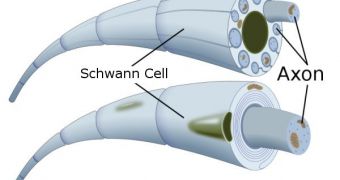A recent study conducted by researchers from the Universities of Cambridge and Edinburgh, revealed a new possible way of reversing the damage caused by multiple sclerosis, which consists in activating the stem cells that can repair injury in the central nervous system.
This is a very important mechanism that helps the regeneration of the insulating layers that protect the nerve fibers in the brain, called myelin sheaths.
“Therapies that repair damage are the missing link in treating multiple sclerosis,” said Professor Robin Franklin, Director of the MS Society's Cambridge Center for Myelin Repair at the University of Cambridge.
“In this study we have identified a means by which the brain's own stem cells can be encouraged to undertake this repair, opening up the possibility of a new regenerative medicine for this devastating disease.”
The researchers carried out experiments in rodents and proved that this mechanism can be put to use to boost new myelin regeneration of the brain's own stem cells.
Multiple sclerosis causes the loss of myelin, which leads to the damage of the nerve fibers in the brain.
The nerve fibers are crucial for the survival of the individual, as they are the ones that send messages to other parts of the body.
The researchers from the two universities believe that their research is a big step forward in finding drugs that would stimulate myelin regeneration in multiple sclerosis patients.
“The aim of our research is to slow the progression of multiple sclerosis with the eventual aim of stopping and reversing it,” said Professor Charles ffrench-Constant, of the University of Edinburgh's MS Society Center for Multiple Sclerosis Research.
“This discovery is very exciting as it could potentially pave the way to find drugs that could help repair damage caused to the important layers that protect nerve cells in the brain.”
MS is a disease that affects nearly 100,000 people in the UK and several millions around the globe, mostly young adults between 20 and 40 years old.
This study was funded by the MS Society in the UK and the National Multiple Sclerosis Society in America, and was published in Nature Neuroscience.

 14 DAY TRIAL //
14 DAY TRIAL //